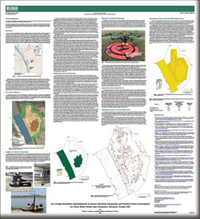Use of High-Resolution Topobathymetry to Assess Shoreline Topography and Potential Future Development of a Slack Water Harbor near Dardanelle, Arkansas, October 2021
Links
- Document: HTML , XML
- Sheet: Report (2.76 MB pdf)
- Data Release: USGS data release - Use of high-resolution topobathymetry to assess shoreline topography and future development of a slack water harbor near Dardanelle, Arkansas, October 2021
- Download citation as: RIS | Dublin Core
Abstract
The U.S. Army Corps of Engineers (USACE), Southwestern Division, Little Rock District Civil Works program has a mission to maintain cohesion between physical and naturally developed environments. The USACE authorized the development of an off-channel harbor (hereinafter referred to as the “proposed slack water harbor”) along the McClellan-Kerr Arkansas River Navigation System at river mile 202.6, and an initial evaluation of shoreline stability and adjacent land near the proposed harbor was considered essential in establishing a baseline for potential effects and future monitoring. In October 2021, the U.S. Geological Survey, in cooperation with the USACE, completed high-resolution bathymetric (underwater elevation) and topographic surveys of the Arkansas River and a quarry at the location of the proposed slack water harbor near Dardanelle, Arkansas, using a combination of multibeam sound navigation and ranging (sonar) and high-resolution, low-altitude aerial light detection and ranging (lidar) data to provide data and analysis needed for as-built information and future monitoring of river shoreline and floodplain management and maintenance.
Bathymetric data were collected using a high-resolution multibeam mapping system, which consists of a multibeam echosounder and an inertial navigation system mounted on a marine survey vessel. Data were collected as the vessel traversed the river and quarry along overlapping survey lines distributed throughout the areas.
Topographic data were collected as a lidar point cloud using an unmanned aircraft system (UAS) with a YellowScan Vx20–100 lidar payload, which consists of the lidar scanner and an inertial navigation system. The lidar point cloud data were collected as the UAS followed two sets of parallel transect lines, oriented perpendicular to each other (nominally north to south and east to west) on separate flights. The bathymetric and UAS topographic datasets were combined with topographic data extracted from publicly available aerial lidar data collected in 2014 to create a multisource point cloud classified as “ground” (code 2) according to the American Society for Photogrammetry and Remote Sensing standard lidar point classes in the proposed harbor area and surroundings, from which topographic contours were derived.
Suggested Citation
Huizinga, R.J., Richards, J.M., and Rivers, B.C., 2022, Use of high-resolution topobathymetry to assess shoreline topography and potential future development of a slack water harbor near Dardanelle, Arkansas, October 2021: U.S. Geological Survey Scientific Investigations Map 3494, 1 sheet, https://doi.org/10.3133/sim3494.
ISSN: 2329-132X (online)
Study Area
Table of Contents
- Acknowledgments
- Introduction
- Data-Collection Methods
- Topobathymetric Surface and Contour Map Creation
- Topobathymetric Surface and Contour Map Quality Assurance
- References Cited
| Publication type | Report |
|---|---|
| Publication Subtype | USGS Numbered Series |
| Title | Use of high-resolution topobathymetry to assess shoreline topography and potential future development of a slack water harbor near Dardanelle, Arkansas, October 2021 |
| Series title | Scientific Investigations Map |
| Series number | 3494 |
| DOI | 10.3133/sim3494 |
| Publication Date | October 25, 2022 |
| Year Published | 2022 |
| Language | English |
| Publisher | U.S. Geological Survey |
| Publisher location | Reston, VA |
| Contributing office(s) | Missouri Water Science Center, Central Midwest Water Science Center |
| Description | Sheet: 36.00 x 39.50 inches; Data Release |
| Country | United States |
| State | Arkansas |
| County | Dardanelle |
| Other Geospatial | Slack Water Harbor |
| Online Only (Y/N) | Y |


